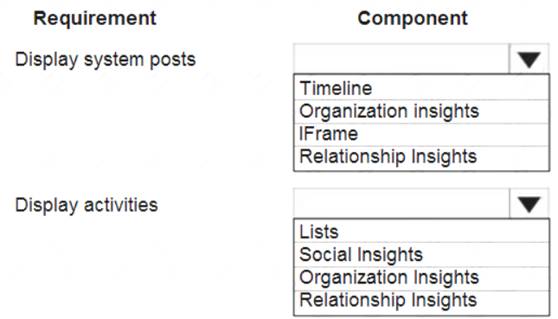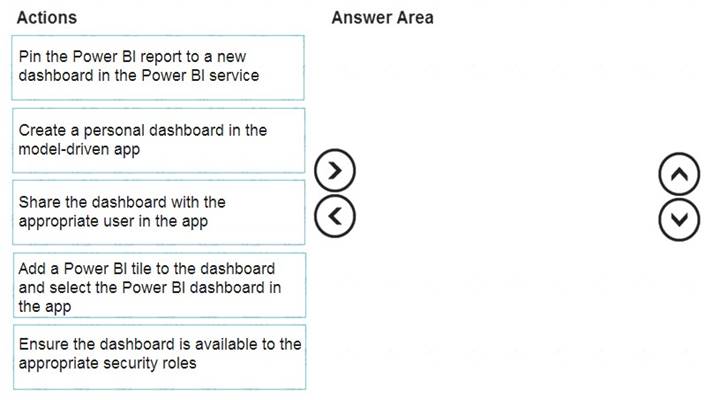- (Exam Topic 3)
Note: This question is part of a series of questions that present the same scenario. Each question in the series contains a unique solution that might meet the stated goals. Some question sets might have more than one correct solution, while others might not have a correct solution.
After you answer a question in this section, you will NOT be able to return to it. As a result, these questions will not appear in the review screen.
You are a Dynamics 365 Sales administrator for a software company. The sales team wants to attach a large number of supporting documents to customer records, but management does not want to incur the cost of additional storage.
The company does not have any Office 365 application integrations enabled. You need to recommend a storage solution that keeps storage costs low. Solution: Enable OneDrive for Business.
Does this meet the goal?
Correct Answer:
B
- (Exam Topic 3)
You are a Dynamics 365 Customer Service administrator.
A user must be able to view system posts and activities in a dashboard. You need to create the dashboard for the user.
Which components should you use? To answer, select the appropriate options in the answer area.
NOTE: Each correct selection is worth one point.
Solution:
Graphical user interface, text, application Description automatically generated
Box 1: Timeline
The timeline helps agents see all customer interaction history across channels, personnel, and the support lifecycle. The timeline is used across Dynamics 365 applications to capture activities like notes, appointments, emails, tasks, and more, to ensure that all interactions with the customer are tracked and visible over time. Agents use the timeline to quickly catch up on all of the latest activity details with the customer to provide the most personalized support experience.
Box 2: Lists Reference:
https://docs.microsoft.com/en-us/dynamics365/customer-service/customer-service-hub-user-guide-timeline-adm
Does this meet the goal?
Correct Answer:
A
- (Exam Topic 3)
You are creating a canvas app.
A user will click a button on each screen of a Power Apps app to proceed to the next screen. You need to implement an action that selects the next screen that the user sees.
Which event should you handle?
Correct Answer:
D
Add navigation
* 1. With the Source screen selected, open the Insert tab, select Icons, and then select Next arrow.
* 2. With the arrow still selected, select the Action tab, and then select Navigate.
* 3. The OnSelect property for the arrow is automatically set to a Navigate function.
* 4. When a user selects the arrow, the Target screen fades in.
* 5. On the Target screen, add a Back arrow, and set its OnSelect property to this formula:
* 6. Navigate(Source, ScreenTransition.Fade)
* 7. While holding down the Alt key, toggle between screens by selecting the arrow on each screen. Reference:
https://docs.microsoft.com/en-us/powerapps/maker/canvas-apps/add-screen-context-variables
- (Exam Topic 3)
A company plans to automate the following manual processes by using Power Automate. You need to identify UI flow types for the two business processes.
Which desktop flow type should you use? To answer, drag the appropriate desktop flow types to the correct business processes. Each desktop flow type may be used once, more than once, or not at all. You may need to drag the split bar between panes or scroll to view content.
NOTE: Each correct selection is worth one point.
Solution:
Graphical user interface, application Description automatically generated
Does this meet the goal?
Correct Answer:
A
- (Exam Topic 3)
You plan to create a Power Virtual Agents bot. The bot must support single sign-on.
You need to publish the bot.
Which two locations should you use? Each correct answer presents a complete solution. NOTE: Each correct selection is worth one point.
Correct Answer:
CD
* C. Azure Bot Service channels: You can configure a Power Virtual Agents bot as a channel in Azure Bot Service. Single sign-on can be configured for the bot using Azure Active Directory (AAD) and the OpenID Connect protocol. This allows you to use your existing AAD users and groups to control access to your bot.
* D. Website developed using pro developer tools: You can embed a Power Virtual Agents bot on a website using the Web Chat control. Single sign-on can be configured for the bot using Azure Active Directory (AAD) and the OpenID Connect protocol. This allows you to use your existing AAD users and groups to control access to your bot.